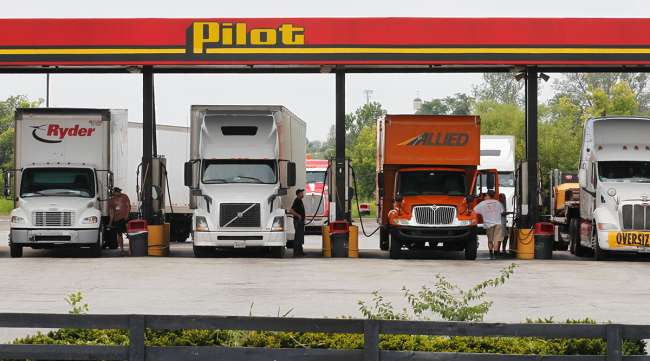Senior Reporter
Diesel Falls 2.3¢ to $3.063 Per Gallon

The U.S. average retail price of diesel fell 2.3 cents to $3.063 a gallon while oil dipped below $60 a barrel in the face of market concerns over increasing domestic production.
It was the fifth consecutive week with the average diesel price above $3 per gallon.
Trucking’s main fuel is 49.8 cents a gallon more expensive than a year ago, the Department of Energy reported after its survey of fueling stations.
The average price of diesel fell in every region of the country, and was below $3 in the Lower Atlantic, Gulf Coast and Rocky Mountain areas, according to DOE’s Energy Information Administration.
The national average price for regular gasoline fell 3 cents to $2.607 a gallon, EIA said. The average is 30 cents higher than it was a year ago.
At the same time, Winter Storm Mateo dumped snow Feb. 8-11 from Idaho to Maine, prompting one company executive to say that fleets are paying closer attention to and taking greater responsibility for the quality of the fuel they use in the winter or summer.
For instance, biofuels will gel, or freeze, at higher temperatures than straight diesel does, according to experts.
“People know to avoid biofuels in the winter if they can. Some states mandate them. People are realizing that the fuel treatments that are on the market for biofuels work. It’s getting to be business as usual, where a few years ago it was more of a crisis,” said Steve Muth, chief chemist for Penray.
Penray, a 67-year-old business, offers diesel fuel additives for improved miles per gallon, and cold weather products to keep heavy-duty trucks running throughout the winter as well as other maintenance products, according to the Wheeling, Ill.-based company.
Summer-related fuel issues faced by fleets include bacterial growth from water in the fuel tanks, he said.
“What I don’t think showed up in the first few years, especially with the biofuels, is if you have a biofuel and a bacterial problem together you get quite a bit of acidity in your tank and people are starting to see corrosion,” Muth said.
Also, fuel distribution centers are handling gasoline with its ethanol component, he said.
If there is cross contamination between lines or pumps or shared tanks of diesel and gasoline, that produces a worst-case scenario of acidity and corrosion, he said.
“Basically, it turns into vinegar, acetic acid,” Muth said. “It ends up in people’s trucks. It ends up in truck stops, but it doesn’t generally come from there. It comes from the fuel storage site,” he said.
Penray recommends people check their fuel tanks in the spring and again in the fall.
When it comes to the quality of the fuel, Muth said: “What we find is there is just a huge difference between people who are on a maintenance program and those who are not — those who treat their fuel with a biocide and use in-tank additives a few times a year or more often.”
Meanwhile, strong demand for crude coupled with restrained output from the Organization of Petroleum Exporting Countries and allied suppliers will erase any remaining glut this year, according to United Arab Emirates Energy Minister Suhail Al Mazrouei in a Bloomberg News report.
West Texas Intermediate crude futures on the New York Mercantile Exchange closed at $59.29 per barrel Feb.12, compared with $64.15 on Feb. 5.
Kuwait Oil Minister Bakheet Al-Rashidi characterized the sell-off as a “correction only.”
“It will come back,” Al-Rashidi said Feb. 12 in remarks to reporters in Kuwait City, adding that he expects world oil demand to increase by about 1.6 million barrels a day this year.
U.S. drillers last week added 26 oil rigs to raise the total number drilling for crude to 791, or 200 more than a year earlier, Baker Hughes Inc. data showed Feb. 9.
Baker Hughes ranks No. 15 on the Transport Topics list of the Top 100 largest private carriers in North America.
Commercial crude oil inventories on Feb. 9 increased by 1.8 million barrels from the previous week to 422.1 million barrels, putting them in the lower half of the average range for this time of year, according to EIA.
Finished gasoline inventories decreased while blending components inventories increased. Inventories of distillate fuel — primarily ultra-low sulfur diesel used in transportation and to a lesser degree as heating oil — decreased by 500,000 barrels and are in the middle of the average range for this time of year.




